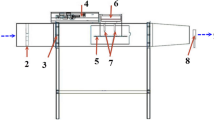Abstract
We made a sensitivity study of the potato flake process using the ERRC Food Process Simulator computer program with cost as the primary objective function. The study showed that labor was the largest component of the processing cost followed by capital related expenses. Pilot plant operation demonstrated the feasibility of reducing labor requirements. Capital related expenses could be minimized by using four drum dryers to more closely match the through put of the rest of the process. In addition, the drum dryers should be run as close to 8% moisture as possible without exceeding 8% to optimize the yield of finished product. This study demonstrates the feasibility of using the ERRC Food Process Simulator to do a sensitivity study of potato processing.
Similar content being viewed by others
Literature Cited
Kozempel, M.F., J.C. Craig, Jr., J.F. Sullivan and W. Damert. 1988. Computer simulation in potato processing. Biotechnol Prog 4(2):63–67.
Wegstein, J.H. 1958. Accelerating convergence of interaction processes. Communications of the Association for Computing Machinery 1:6–9.
Kozempel, M.F., J.F. Sullivan and J.C. Craig, Jr. 1981. Model for blanching potatoes and other vegetables. Lebensm-Wiss u-Technol 14:331–335.
Kozempel, M.F., J.F. Sullivan and J.C. Craig, Jr. 1983. Effect of temperature on the model for blanching potatoes and other vegetables. Lebensm-Wiss u-Technol 16:338–342.
Kozempel, M.F., J.F. Sullivan and J.C. Craig, Jr. 1985. Modelling and simulating commercial hot water blanching of potatoes. Am Potato J 62:69–82.
Kozempel, M.F. 1988. Modelling the kinetics of cooking and precooking potatoes. J Food Sci 53:753–755.
Kozempel, M.F., J.F. Sullivan, J.C. Craig, Jr. and W.K. Heiland. 1986. Drum Drying potato flakes. A predictive model. Lebensm-Wiss u-Technol 19:193–197.
Kozempel, M.F., P.M. Tomasula, J.C. Craig, Jr. and M.J. Kurantz. 1990. Effect of potato composition on drum dryer capacity. Lebensm-Wiss u-Technol 23:312–316.
Anon. Economic Indicators. 1989. Chemical Engineering 96(8):206.
Talburt, W.F. and O. Smith. 1987. Potato Processing, 4th Ed., Van Nostrand Reinhold Co., New York, NY p. 23.
Author information
Authors and Affiliations
Additional information
Mention of brand or firm names does not constitute an endorsement by the U.S. Department of Agriculture over others of a similar nature not mentioned.
Rights and permissions
About this article
Cite this article
Kozempel, M.F., Tomasula, P. & Craig, J.C. Simulation and sensitivity study of potato flake food processing. American Potato Journal 70, 93–100 (1993). https://doi.org/10.1007/BF02857177
Accepted:
Issue Date:
DOI: https://doi.org/10.1007/BF02857177




